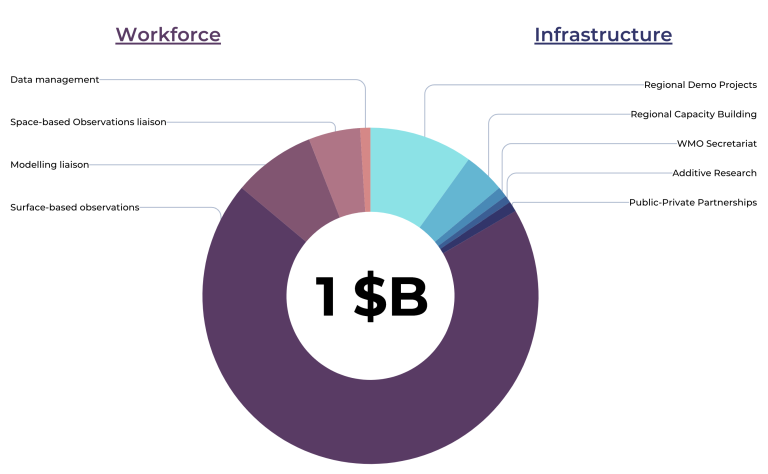G3W Finance
Financial estimates and funding sources
The cost estimates are articulated in, (i) costs for the G3W coordination that can be precisely assessed based on projected Full-Time Equivalents (FTEs) and logistics expenditure that are cluster under the label “Workforce” and include both Capacity Development and Coordination (ii) costs for the observations, modelling and data management building blocks that are clustered under the label “Infrastructure”, where estimates rely on sectoral studies by reputable sources.
It is fully acknowledged that the global efficiency for G3W will be achieved by the complementarity of efforts supported by centralized and regionalized investments, with funding sources detailed in section 11, and do not involve directly the NMHSs, if not as voluntary donors.
The Flagship level funding scenario at 1 B$ over the financial period 2024–2027 period is a target of the G3W resource mobilization, while lower funding scenarios are illustrated in the full implementation plan to illustrate the resources partitioning in case of partial attainment. Note that these resources are expected to come from the financial sectors, including the World Bank, Central Banks, Multilateral Development Banks, Insurances and Reinsurances, Philanthropies, Climate finance grants, Loss and damage funds, as well as from Industrial sectors via Environmental, Social, and Governance (ESG) practices alongside more traditional financial measures driven by socially responsible investing.
The G3W Flagship level costed plan identified as top priority the surface-based observations, representing 70% of the investment, followed by 14% in observations integration, modelling and data management, 10% in regional demonstration projects, 7% in additive research, 3% in public-private-partnership (PPP) development, and 1% in the central coordination by the WMO Secretariat.
The G3W economic benefits from the surface-based observations network are expected to be well above 25 times the value of the investment[1] and compared to the estimated cost of surface-based and space-based operational weather observations of 10 B$ per year, it represents less than 2.5% increase in the annual costs.

About G3W Trust Fund
G3W trust fund donations will first allow implementation of the first important pillars of the G3W-IP, starting within 2024 from the survey of existing and emerging technologies that can support a global basic observing network for greenhouse gases, and the global and regional modelling systems. The impact of this survey will guide a G3W surface-based network design, define the G3W systems requirements and outputs, and develop the supporting R&D strategy for identified high-priority pre-operational needs.
You considered supporting the G3W initiative ? Let’s have a talk!
